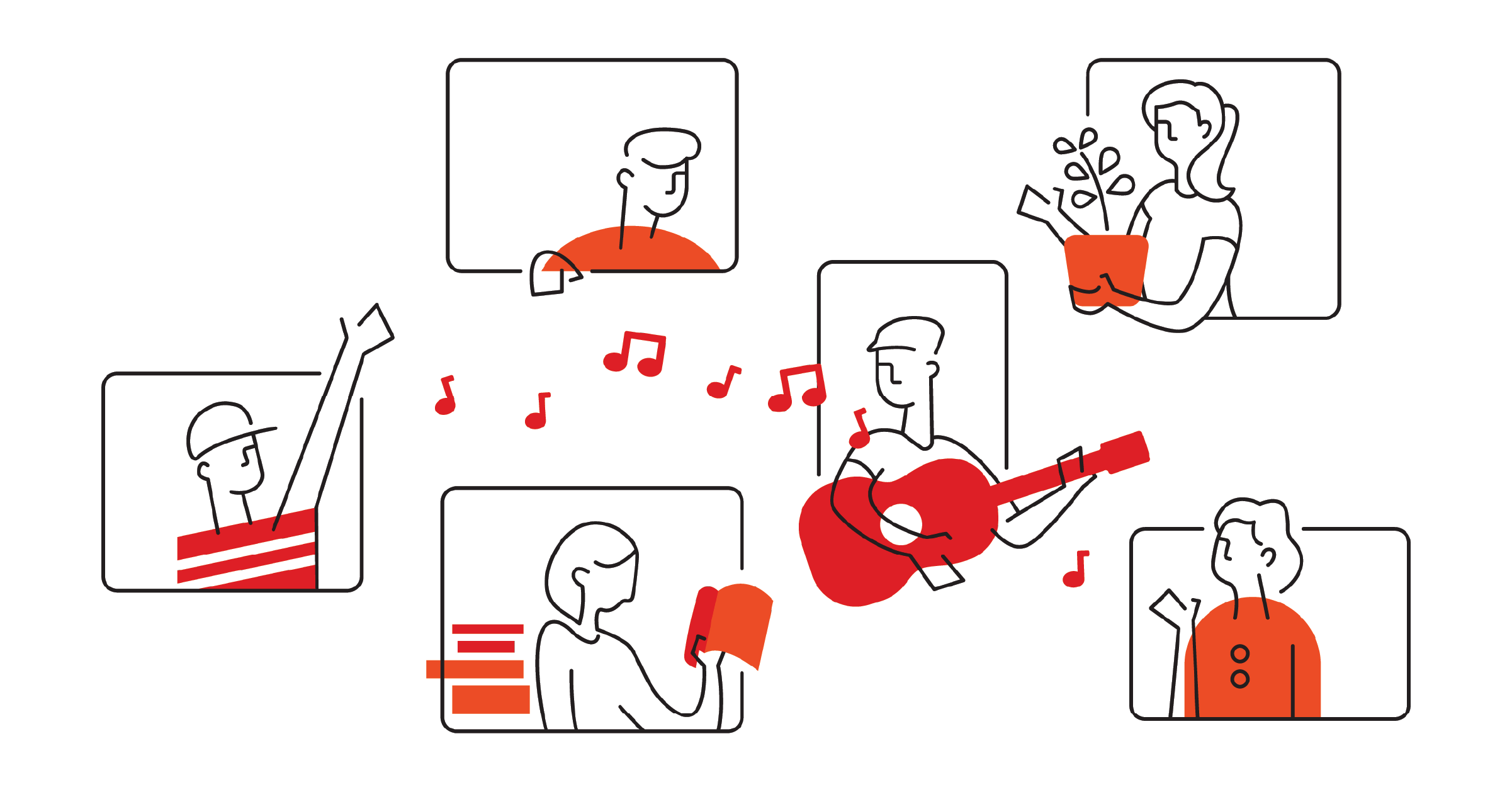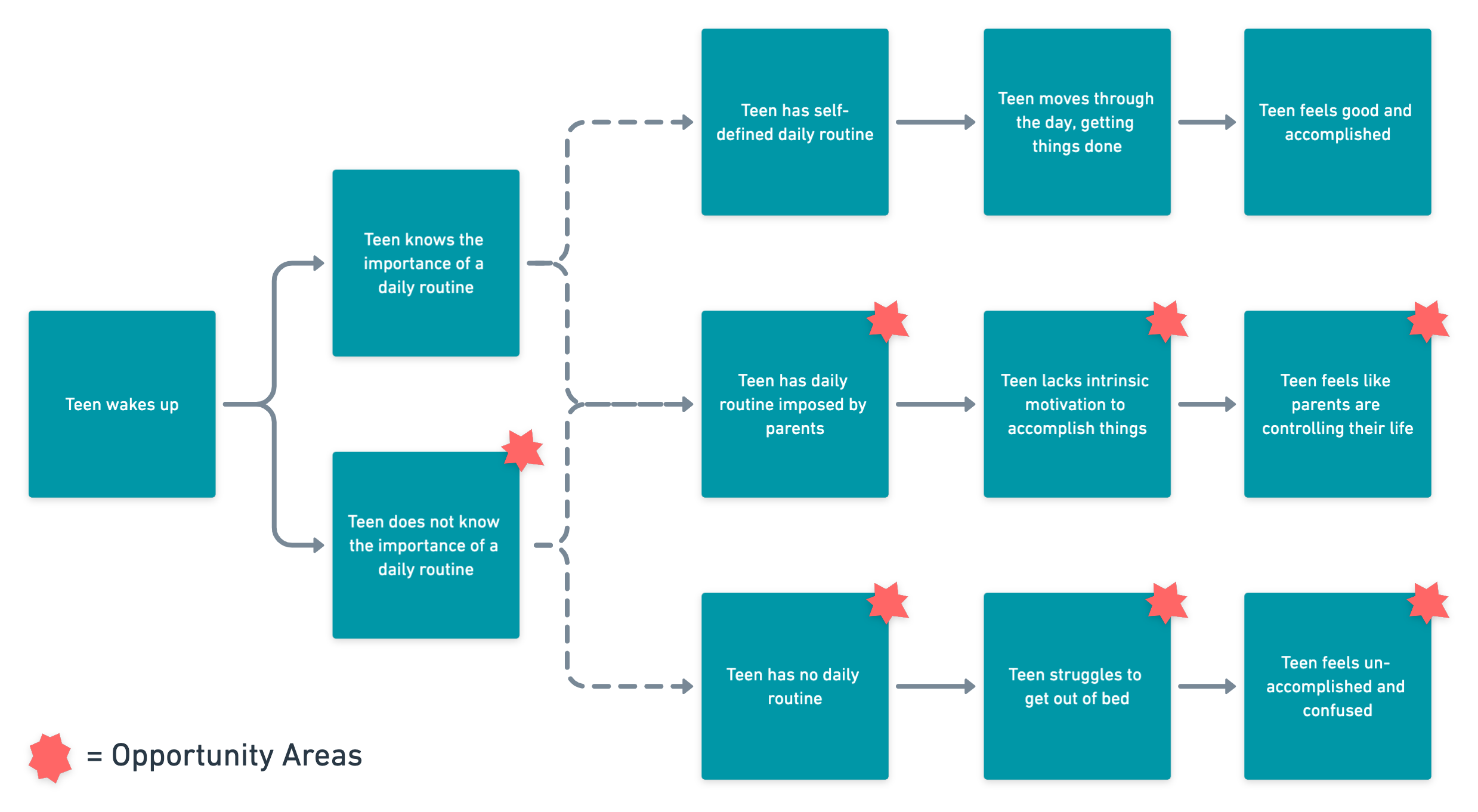Teen Social Distancing
A research collaboration with the Emergency Design Collective on helping teens with social distancing during the pandemic
TOOLS
Adobe Illustrator, Miro Board
METHODS + SKILLS
UX Research, User Interviews, Human Centered Design Thinking, Visual Design
DURATION
6 weeks
TEAM
Pam Taylor* (Team Lead), Labiba Amyeen, Alia Bayatti, Shuge Luo, Teresa Pho, Komal Trivedi, Dottie Monares
overview
The Emergency Design Collective was a cooperative of designers, project managers, and healthcare workers who came together at the beginning of the pandemic to help combat a wide range of issues brought on by the pandemic. My team focused specifically on helping teenagers grapple with the pandemic and find ways to social distance while taking care of the minds and bodies.
THE ASK
How might we improve the experience of social distancing for high school teens aged 14-18?
THE ASK
COVID-19 quarantine is impacting all facets of teens’ lives, leading to negative emotional, social, and educational repercussions.
Teens between the age of 14-18 are in the stage of self-definition, where social interactions with peers help lay the foundation for their identity outside of the home. However, due to stay-at-home orders, teens’ education, extracurriculars, and social lives have been cancelled or moved online. This leaves teens with less external structure, more free time, and more time alone. Many teens do not know how to cope with these changes, leading to increased levels of apathy, lethargy, and in some cases anxiety and depression.
context
process
We took a human-centered approach to address this challenge, conducting primary and secondary research to inform design efforts.
primary research
Interviewed teens about their daily lives, challenges, and successes during quarantine
Interviewed people in teens’ support networks, including psychologists, teachers, and parents
secondary research
Reviewed current events journalism and academic literature about teens’ experiences during this time and associated mental health challenges
PRIMARY RESEARCH
the interviewees
Teens
Located in urban, suburban, and rural areas
Aged 13 to 19 years old
Have high and low access to technology
Attend public and private schools
People who support teens
Psychologists
School teachers
Parents of high schoolers
user journeys
After speaking with teens and their caregivers, teachers and psychologists alike we consolidated our research findings in a couple of journey maps and identified different pain points and opportunity areas within the daily routines of teens.
A DAY IN THE LIFE OF A QUARAN-TEEN
QUARAN-TEEN ROUTINE STRUGGLES
SYNTHESIS
research insights
From our research we were able to consolidate 5 key insights about our quaran-teens. In the following segment I will expand on these insights and provide design opportunities that rise from these insights.
The lack of structure, routine, and the rhythm of school are causing teens to feel disoriented.
Hobbies and new rituals are providing teens with an anchor and sense of purpose.
Teens are increasingly turning to screens to cope with new mental burdens and unstructured time.
Teens long for deeper connections with peers, but are limited to building and maintaining relationships virtually.
Anxiety and depression are on the rise among teens, and avenues for healthily coping are limited.
INSIGHT #1
Teens have seen their daily lives upended. The lack of external structure has caused teens to feel confused and lethargic. One teen says, “Overall, I feel like I’ve gotten super lazy….I don’t usually feel like going outside, and some days sit on my bed and chill.”
Ungraded school assignments and lack of in-person social accountability are inhibiting teens’ability to focus and be motivated on studies or other projects. One teen shares how his schoolwork is done from bed: “I wake up, eat breakfast and do everything else I'd normally do, and then I get back in bed and go to class."
Teens desire variety in routines and things to look forward to, but during quarantine, the days blend together. Interviewees mentioned that normally, with school work, teens have something to look forward to on the weekends. However, in quarantine, this reward of the weekend is less compelling. One teen remarks, “All the days blur together...I don’t want to get up, I don’t want to live the same day over.”
Some teens are successful in building their own routines, and are enjoying the freedom allowed by an open schedule. One teen shares, "I like doing my own stuff - I can have my own schedule... Now that I have my own time, I can get my stuff done, and then I can relax."
The lack of structure, routine, and the rhythm of school are causing teens to feel disoriented and unmotivated.
INSIGHT #2
Teens are finding hobbies and new rituals to fill their time. One psychologist shares that teens who are doing the best have a passion project that they are throwing themselves into, like a new pet, woodworking, photography, or the stock market.
These new activities are filling in gaps of time, motivation, and purpose. One teen shares, “I started sewing again, making clothes, and being more creative. One of the only positives of being in quarantine is finding old hobbies.”
Teens are also finding new ways to celebrate big events. Teens have listened to President Obama’s commencement speech or danced at Some Good News prom. One teen shares, "In our friend group we’ve had two birthdays, we all drove to their houses and stayed six feet apart and sang happy birthday...”
Hobbies and new rituals are providing teens with an anchor and sense of purpose.
INSIGHT #3
Some teens are using screens as a form of escapism. Teens who were prone to anxiety, depression, or ADHD before COVID-19 are now “taking [screen use] to the extreme. One teen remarks, ”I do know using technology is bad [for my health]… but my sadness outweighs my health, so I’m zoning into the games, music, or TV.”
Other teens are turning to social media as a creative outlet to connect with others, educate themselves about the pandemic, and express themselves. For example, teens are sharing TikTok dances, reconnecting with old friends via Houseparty, and playing social video games like Minecraft.
Screentime is negatively affecting teens’ physical wellbeing. Between virtual school and social activities, teens are physically exhausted and experiencing migraines. Schools only schedule 30-minute classes to support less screen time. One teen aptly acknowledges her screen fatigue, “I’m done with screens.”
Teens are increasingly turning to screens to cope with new mental burdens and unstructured time.
INSIGHT #4
Teens are struggling with the inability to see friends. One teen remarks how her biggest need is to socialize with her friends. Many teens’ parents do not allow them to see their friends in person and “feel suffocated” in the home. One teen reflects,"After quarantine, I want to hang out with my friends a lot more... I'm gonna be more extroverted."
Teens are using the internet to reconnect with friends or meet new people. However, some find it difficult to build and maintain relationships virtually. One teen remarks, “I find it awkward to call my friends.”
One psychologist shares that although many kids are interacting with close friends over the internet, they are lacking the important school day interactions with random peers.
Teens long for deeper connections with peers, but are limited to building and maintaining relationships virtually.
INSIGHT #5
Teens are feeling many negative emotions, including apathy, lethargy, lack of motivation, uncertainty, and in some cases, increased levels of anxiety and depression. Teens feel they are accomplishing less, which can be detrimental to their self esteem. Teens are unable to see friends and celebrate big events, making them feel disappointed and trapped.
Normal life has been upended and no one really has the answers. With so much uncertainty about the future, even parents’stresses have been magnified. One psychologist shares how, “Even kids who have warm and nurturing relationship with their parents experience more mutual frustration.”
Teens need time and space to process current events. One teen says, “Don’t give us more homework, don’t give us more things to do. Why add another things to our lives to make it harder?”
A psychologist shares how some parents desire their child to come out of this with more skills; perhaps, he says, their child will learn a new language. However, that psychologist emphasizes, “This is a time about surviving. If you get through with your mental health intact, you’ve established a great deal of resiliency.”
Anxiety and depression are on the rise among teens, and avenues for healthily coping are limited.
IDEATION
design opportunities
#1 Empower teens to find hobbies and new rituals
With hobbies and rituals as a pillar of positivity during social distancing, we can help by connecting teens with ideas, resources, and accountability to pursue new hobbies and rituals.
HMW SUPPORT TEENS IN FINDING NEW ACTIVITIES?
#2 Energize teens to take care of their mental health
For teens who are struggling emotionally during this time, we can help by connecting them to existing resources to manage anxiety, depression, and loneliness.
HMW INCREASE TEENS' AWARENESS OF MENTAL HEALTH?
#3 Support teens with adapting to less external structure
For teens who have not been able to build their own routines, we can help by aggregating information about the importance of routines and create resources to get them started.
HMW HELP TEENS CREATE ROUTINES?
#4 Encourage teens to use screens in a healthy way
For many teens who are using screens excessively, we can help by creating screen time challenges and encouraging analog hobbies.
HMW HELP TEENS MANAGE THEIR SCREEN TIME?
Prioritize ease of use.
A lot of things feel challenging right now, and we not want to add to that burden. Our solutions should be easy for all teens to engage with.
guiding principles
Create with teens.
Teenagers want to feel included and want their voices to be heard. Our solutions should be collaborative; for teens, by teens.
Build for varying access to technology.
Some teens do not have easy access to technology like consistent wi-fi, computers, and tablets. Our solutions should not be limited to a high-tech audience.
Here are a list of things to keep in mind while we are designing for teens
success metrics
Have significant impact
Designs should be able to reach a large audience of individuals and improve their quality of life
Require little resource investment
Designs should be able to be executed using existing materials and technologies
Be possible to execute quickly using EDC’s existing skill sets
Given the great need of teens during COVID-19, designs should be able to have a quick turnaround time tapping into existing partners
initial conceptualization
#MyRouteen Website
Through a mobile-friendly website, we will share resources with teens and parents about the importance of a daily routine. This will include a customizable and shareable daily routine template and examples of extraordinary routines.
HMW HELP TEENS CREATE ROUTINES?
Accountability Group Playbook
Through an easy to navigate digital resource guide, we will provide best practices and resources for starting different kinds of community groups. We are encouraging teenagers to start small, intimate circles that are highly connected and personalized.
HMW SUPPORT TEENS IN FINDING NEW ACTIVITIES?
Social Media Challenges
We will develop and share weekly social media challenges for teens that encourage decreasing screen time and finding new analog activities. These challenges include: sharing family-oriented analog activities with followers, being held accountable for developing new hobbies, and competing for the lowest amount of screen time.
HMW HELP TEENS MANAGE THEIR SCREEN TIME? // HMW SUPPORT TEENS IN FINDING NEW ACTIVITIES?
REFLECTION
concluding sentiments
This project is from the very beginning of the pandemic. Since then, we’ve loosened and tightened restrictions. Teens have gone back to school. Some of our respondents may have even graduated. The bottom line is the world has changed. While that may be the case a lot of the insights gained from this research still apply as teens and young people grapple with the ramifications of a forever-changing world. While the initial ideations we presented may no longer be as relevant, the research and insights gleaned from this project are still very much relevant.





